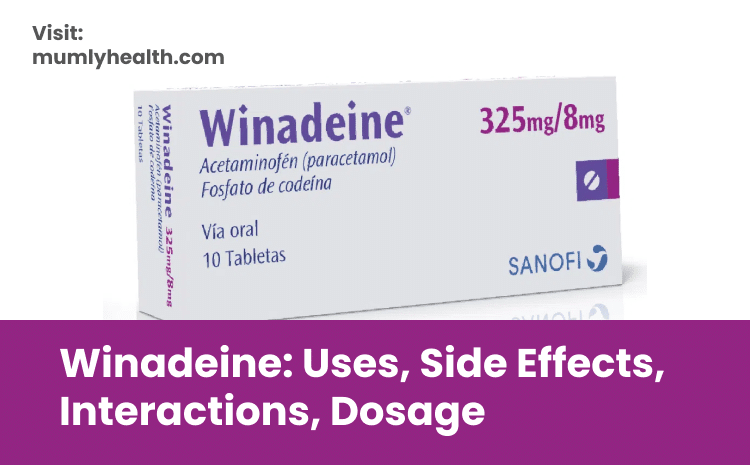Winadeine has emerged as a trusted ally for countless individuals seeking relief from various ailments. Whether it’s a throbbing headache, a persistent backache, or any other form of discomfort, Winadeine has proven itself to be a reliable solution.
In this comprehensive guide, we will delve into the intricacies of Winadeine, shedding light on its composition, medical uses, potential side effects, and much more.
Composition and Ingredients:
At the heart of Winadeine’s efficacy lies its carefully curated composition. This medication typically contains a combination of two active ingredients: codeine and paracetamol (also known as acetaminophen).
Codeine belongs to the opioid family and functions as a pain-reliever and cough suppressant, while paracetamol acts as a fever reducer and mild analgesic.
In addition to these key components, Winadeine may also contain inert substances to facilitate its formulation and administration.
Read Also: 44 291 Pill Orange Round | Uses, Side Effects, Interactions, Dosage and More
Medical Uses and Indications:
Winadeine’s versatility is evident in its wide range of medical applications. Physicians often prescribe it to alleviate moderate to severe pain stemming from conditions such as headaches, dental pain, musculoskeletal discomfort, and postoperative recovery.
Its combination of codeine and paracetamol provides a dual approach to pain relief, targeting different pain pathways for enhanced effectiveness.
Medical Uses
- Pain Relief: Winadeine is commonly prescribed for the management of moderate to moderately severe pain. This includes various types of pain such as headaches, dental pain, menstrual cramps, musculoskeletal pain, and postoperative discomfort.
- Fever Reduction: The paracetamol component of Winadeine serves as a fever reducer. It can be used to lower elevated body temperatures associated with fever caused by infections, inflammatory conditions, or other factors.
- Headache: Winadeine can provide effective relief for tension headaches, migraines, and other types of headaches that may result from different causes.
- Dental Pain: Dental procedures or conditions such as tooth extraction, root canal treatment, or dental abscesses can lead to significant pain. Winadeine may be prescribed to manage this pain.
- Musculoskeletal Pain: Conditions like back pain, muscle strains, and joint pain can be managed with Winadeine, helping to alleviate discomfort and improve mobility.
- Postoperative Recovery: After surgical procedures, patients may experience pain as a part of the recovery process. Winadeine can help manage postoperative pain, allowing patients to heal more comfortably.
Potential Side Effects:
- Nausea: Some individuals may experience feelings of nausea or an upset stomach after taking Winadeine.
- Drowsiness: The codeine component in Winadeine can cause drowsiness or sedation, affecting alertness and coordination.
- Dizziness: Dizziness or lightheadedness may occur, particularly when standing up quickly.
- Constipation: Codeine is known to slow down bowel movements, potentially leading to constipation.
- Dry Mouth: A dry, parched feeling in the mouth might occur as a result of taking Winadeine.
- Respiratory Depression: In rare cases, codeine can suppress the respiratory system, leading to slow or shallow breathing.
Precautions and Contraindications:
Precautions:
- Medical History: Individuals with a history of substance abuse, including opioids, should exercise caution when using Winadeine due to the presence of codeine. Inform your healthcare provider about any history of drug dependence or addiction.
- Respiratory Conditions: People with respiratory disorders such as asthma, chronic obstructive pulmonary disease (COPD), or sleep apnea should use Winadeine cautiously, as codeine can suppress the respiratory system and potentially worsen breathing difficulties.
- Liver Function: Winadeine contains paracetamol, which is metabolized by the liver. Individuals with liver disease or impaired liver function should use Winadeine under close medical supervision, as excessive paracetamol consumption can lead to liver damage.
- Kidney Function: Kidney function plays a role in eliminating codeine and its metabolites from the body. Individuals with impaired kidney function should be monitored carefully while using Winadeine.
- Pregnancy and Breastfeeding: Pregnant or breastfeeding individuals should consult a healthcare provider before using Winadeine. Codeine use during pregnancy can lead to neonatal withdrawal symptoms or other complications.
- Elderly Population: Elderly individuals may be more susceptible to the sedative effects of codeine and the side effects of Winadeine. A lower dosage or alternative pain management options might be considered.
Contraindications:
- Allergic Reaction: Individuals who have experienced allergic reactions to codeine, paracetamol, or any other component of Winadeine should not use this medication.
- Respiratory Depression: People with severe respiratory depression, acute asthma exacerbation, or other significant breathing difficulties should avoid Winadeine due to the risk of exacerbating these conditions.
- Acute Alcohol Intoxication: Avoid using Winadeine if you are experiencing acute alcohol intoxication, as it can increase the risk of central nervous system depression.
- Monoamine Oxidase Inhibitors (MAOIs): Concomitant use of Winadeine with MAOIs or within two weeks of discontinuing MAOI therapy can lead to a dangerous interaction causing serotonin syndrome, a potentially life-threatening condition.
- Severe Liver Disease: Individuals with severe liver disease or acute liver failure should avoid Winadeine due to the risk of worsening liver function.
Interactions with Other Substances
Winadeine’s interaction with other substances, particularly alcohol and certain medications, demands attention.
Combining Winadeine with alcohol or other central nervous system depressants can intensify sedative effects and increase the risk of adverse reactions.
Always inform your healthcare provider of any ongoing medications or substances you are using to ensure safety.
Conclusion
Winadeine stands as a testament to the remarkable advancements in pain management, providing a synergistic blend of codeine and paracetamol to alleviate discomfort. While its benefits are noteworthy, responsible and informed usage is paramount.
By understanding its composition, medical uses, potential side effects, and more, individuals can harness the power of Winadeine to improve their quality of life while prioritizing their health and well-being.
